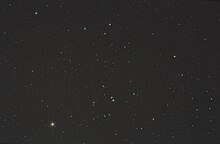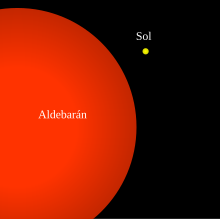Aldebaran
Aldebaran (Alpha Tauri / α Tau / 87 Tauri / HIP 21421) is the brightest star in the constellation Taurus ("The Bull") and the 13th brightest in the night sky. Of apparent magnitude +0.85, it is orange-red. Although visually it appears to be the brightest member of the Hyades open cluster, it is actually not part of the open cluster and is simply in the same line of sight. Along with Sirius (α Canis Majoris) and Arthur (α Bootis), it enabled Edmund Halley to discover the proper motion of the stars by comparing their current positions with those in ancient catalogues.
Name
The name Aldebaran comes from the Arabic الدبران, al-dabarān, meaning "the one that follows", in reference to the fact that this star follows the cluster of the Pleiades on its nocturnal journey through the sky. Numerous popular fables use it to designate the persevering man and woman who does not accept defeat.
Ptolemy called her "bearer of the torch," and in Greek she also received the name Omma Boos, a name that was later translated literally into Latin: Oculus Tauri (eye of the bull). In the 17th century, the astronomer Giovanni Riccioli called it more specifically Oculus Australis («eye of the south").
In Persia the star was known as Taschter. The Persian astronomer Al Biruni cited Al Fanik ("the stallion camel"), Al Fatik ("the fat camel") and Al Muhdij ("the female camel") as indigenous Arabic names for this star. In ancient Rome it was called Palilicium, a term that comes from Palilia or Parilia, the feast of Pales, a pastoral divinity from Roman mythology. The title Hrusa designated this star in ancient Bohemia.
In Hindu astronomy, she is identified with the nakshatra — lunar mansion — of Rohini, and is one of the twenty-seven daughters of Daksha and the wife of the god Chandra.
Physical characteristics
Located 65.1 light-years away, Aldebaran is an orange giant star of spectral type K5III with a surface temperature of 4010 K. Being close to the ecliptic it is periodically occulted by the Moon and, thanks to this, it has been possible to measure its angular diameter, 0.020 seconds of arc, which leads to a radius 44 times greater than the solar radius. Situated in the place of the Sun, it would extend halfway through the orbit of Mercury, and in Earth's sky it would appear as a disk 20° in diameter. Its projected rotation speed is 5.2 km/s, so its rotation period can be up to 400 days.
Aldebaran is 425 times more luminous than the Sun but its mass is only 1.7 solar masses; Given the enormous size of this star, its average density turns out to be much lower than that of the Sun. Unlike most orange giants, which are fusing helium into carbon and oxygen in their core, Aldebaran would be in a preliminary state in which its still inert helium core would be in the process of contracting and heating up, causing it to Together, the star expands and increases in brightness. It is beginning to lose mass by means of a stellar wind that engulfs the star to a distance of 100 au. Within just a few million years, the star will reach a luminosity 800 times that of the Sun, at which point helium burning will begin and core contraction will slow, leading to a decrease in brightness. Aldebaran is classified as an irregular pulsating variable, with a brightness fluctuation of 0.2 magnitudes.
Aldebaran is a binary system: the giant star has a small, distant companion, Aldebaran B, of magnitude +13.50. It is a red dwarf of spectral type M2V, whose mass may be as little as 15% of the solar mass and its radius 36% of the solar radius. Its current separation from Aldebaran A is 609 au.
The Pioneer 10 probe is currently heading towards Aldebaran, where it will arrive in 1,690,000 years.
Possible planetary companion
In 1997 it was announced the discovery of a giant planet, Aldebaran b, about 9.5 Jupiter masses, in orbit around the main star. The discovery was doubtful and was not confirmed until 2015. In fact, it is difficult to detect the existence of a substellar companion around a highly evolved star like Aldebaran, since giant stars, being often pulsating stars, show oscillations in their speed. analogous to those caused by the presence of planets.
Contenido relacionado
Julian date
Canadian Space Agency
Heliocentric theory

